ZHCSG07 February 2017 TPS7A4701-EP
PRODUCTION DATA.
- 1 特性
- 2 应用
- 3 说明
- 4 修订历史记录
- 5 Pin Configuration and Functions
- 6 Specifications
- 7 Detailed Description
- 8 Application and Implementation
- 9 Power Supply Recommendations
- 10Layout
- 11器件和文档支持
- 12机械、封装和可订购信息
6 Specifications
6.1 Absolute Maximum Ratings
Over junction temperature range, unless otherwise noted(1)| MIN | MAX | UNIT | ||||
|---|---|---|---|---|---|---|
| Voltage(2) | IN pin to GND pin | –0.4 | 36 | V | ||
| EN pin to GND pin | –0.4 | 36 | V | |||
| EN pin to IN pin | –36 | 0.4 | V | |||
| OUT pin to GND pin | –0.4 | 36 | V | |||
| NR pin to GND pin | –0.4 | 36 | V | |||
| SENSE/FB pin to GND pin | –0.4 | 36 | V | |||
| 0P1V pin to GND pin | –0.4 | 36 | V | |||
| 0P2V pin to GND pin | –0.4 | 36 | V | |||
| 0P4V pin to GND pin | –0.4 | 36 | V | |||
| 0P8V pin to GND pin | –0.4 | 36 | V | |||
| 1P6V pin to GND pin | –0.4 | 36 | V | |||
| 3P2V pin to GND pin | –0.4 | 36 | V | |||
| 6P4V1 pin to GND pin | –0.4 | 36 | V | |||
| 6P4V2 pin to GND pin | –0.4 | 36 | V | |||
| Current | Peak output | Internally limited | ||||
| TJ | Operating virtual junction | –55 | 150 | °C | ||
| Tstg | Storage temperature | –65 | 150 | °C | ||
(1) Stresses beyond those listed under Absolute Maximum Ratings may cause permanent damage to the device. These are stress ratings only, which do not imply functional operation of the device at these or any other conditions beyond those indicated under Recommended Operating Conditions. Exposure to absolute-maximum-rated conditions for extended periods may affect device reliability.
(2) All voltages are with respect to network ground terminal.
6.2 ESD Ratings
| MIN | MAX | UNIT | ||||
|---|---|---|---|---|---|---|
| V(ESD) | Electrostatic discharge | Human-body model (HBM), per ANSI/ESDA/JEDEC JS-001, all pins(1) | –2500 | 2500 | V | |
| Charged-device model (CDM), per JEDEC specification JESD22-C101, all pins(2) | –500 | 500 | ||||
(1) JEDEC document JEP155 states that 500-V HBM allows safe manufacturing with a standard ESD control process.
(2) JEDEC document JEP157 states that 250-V CDM allows safe manufacturing with a standard ESD control process.
6.3 Recommended Operating Conditions
over junction temperature range (unless otherwise noted)| MIN | NOM | MAX | UNIT | ||
|---|---|---|---|---|---|
| VI | 3.0 | 35 | V | ||
| VO | 1.4 | 34 | V | ||
| VEN | 0 | VIN | V | ||
| IO | 0 | 1 | A | ||
6.4 Thermal Information
| THERMAL METRIC(1) | TPS7A4701-EP | UNIT | |
|---|---|---|---|
| RGW | |||
| 20 PINS | |||
| RθJA | Junction-to-ambient thermal resistance | 32.5 | °C/W |
| RθJC(top) | Junction-to-case (top) thermal resistance | 27 | °C/W |
| RθJB | Junction-to-board thermal resistance | 11.9 | °C/W |
| ψJT | Junction-to-top characterization parameter | 0.3 | °C/W |
| ψJB | Junction-to-board characterization parameter | 11.9 | °C/W |
| RθJC(bot) | Junction-to-case (bottom) thermal resistance | 1.7 | °C/W |
(1) For more information about traditional and new thermal metrics, see the IC Package Thermal Metrics application report, SPRA953.
6.5 Electrical Characteristics
At –55°C ≤ TJ ≤ 125°C; VI = VO(nom) + 1 V or VI = 3 V (whichever is greater); VEN = VI; IO = 0 mA; CIN = 10 µF; COUT = 10 µF; CNR = 10 nF; SENSE/FB tied to OUT; and 0P1V, 0P2V, 0P4V, 0P8V, 1P6V, 3P2V, 6P4V1, 6P4V2 pins OPEN, unless otherwise noted.| PARAMETER | TEST CONDITIONS | MIN | TYP | MAX | UNIT | |||
|---|---|---|---|---|---|---|---|---|
| VI | Input voltage range | 3 | 35 | V | ||||
| VUVLO | Under-voltage lockout threshold | VI rising | 2.67 | V | ||||
| VI falling | 2.5 | |||||||
| V(REF) | Reference voltage | V(REF) = V(FB) | 1.4 | V | ||||
| VUVLO(HYS) | Under-voltage lockout hysteresis | 177 | mV | |||||
| VNR | Noise reduction pin voltage | Using ANY-OUT option | VOUT | V | ||||
| Using adjustable option | 1.4 | |||||||
| VO | Output voltage range | VI ≥ VO(nom) + 1 V or 3 V (whichever is greater), COUT = 20 µF |
Using ANY-OUT option | 1.4 | 20.5 | V | ||
| Using adjustable option | 1.4 | 34 | ||||||
| Nominal accuracy | TJ = 25°C, COUT = 20 µF | –1 | 1 | %VO | ||||
| Overall accuracy | VO(nom) + 1 V ≤ VI ≤ 35 V, 0 mA ≤ IO ≤ 1 A, COUT = 20 µF |
–3.5 | 3.5 | |||||
| ΔVO(ΔVI) | Line regulation | VO(nom) + 1 V ≤ VI ≤ 35 V | 0.092 | %VO | ||||
| ΔVO(ΔIO) | Load regulation | 0 mA ≤ IO ≤ 1 A | 0.3 | %VO | ||||
| V(DO) | Dropout voltage | VI = 95% VO(nom), IO = 0.5 A | 216 | mV | ||||
| VI = 95% VO(nom), IO = 1 A | 307 | 450 | ||||||
| I(CL) | Current limit | VO = 90% VO(nom) | 1 | 1.26 | A | |||
| I(GND) | Ground pin current | IO = 0 mA | 0.58 | 1 | mA | |||
| IO = 1 A | 6.1 | |||||||
| I(EN) | Enable pin current | VEN = VI | 0.78 | 2 | µA | |||
| VI = VEN = 35 V | 0.81 | 2 | ||||||
| I(SHDN) | Shutdown supply current | VEN = 0.4 V | 2.55 | 8 | µA | |||
| VEN = 0.4 V, VI = 35 V | 3.04 | 60 | ||||||
| V+EN(HI) | Enable high-level voltage | 2 | VI | V | ||||
| V+EN(LO) | Enable low-level voltage | 0 | 0.4 | V | ||||
| I(FB) | Feedback pin current | 350 | nA | |||||
| PSRR | Power-supply rejection ratio | VI = 16 V, VO(nom) = 15 V, COUT = 50 µF, IO = 500 mA, CNR = 1 µF, f = 1 kHz |
78 | dB | ||||
| Vn | Output noise voltage | VI = 3 V, VO(nom) = 1.4 V, COUT = 50 µF, CNR = 1 µF, BW = 10 Hz to 100 kHz |
4.17 | µVRMS | ||||
| VIN = 6 V, VO(nom) = 5 V, COUT = 50 µF, CNR = 1 µF, BW = 10 Hz to 100 kHz |
4.67 | |||||||
| Tsd | Thermal shutdown temperature | Shutdown, temperature increasing | 170 | °C | ||||
| Reset, temperature decreasing | 150 | |||||||
| TJ | Operating junction temperature | –55 | 125 | °C | ||||
6.6 Typical Characteristics
At –55°C ≤ TJ ≤ 125°C; VI = VO(nom) + 1 V or VI = 3 V (whichever is greater); VEN = VI; IO = 0 mA; CIN = 10 µF; COUT = 10 µF; CNR = 1 µF; SENSE/FB tied to OUT; and 0P1V, 0P2V, 0P4V, 0P8V, 1P6V, 3P2V, 6P4V1, 6P4V2 pins OPEN, unless otherwise noted.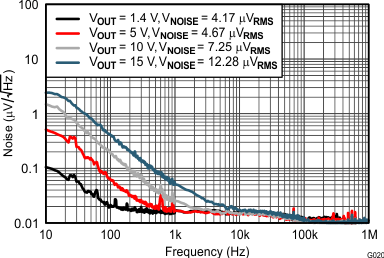
| IOUT = 500 mA | COUT = 50 µF | CNR = 1 µF |
| BWRMSNOISE (10 Hz, 100 kHz) | ||
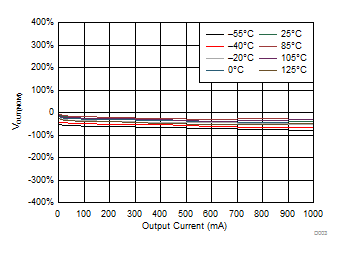
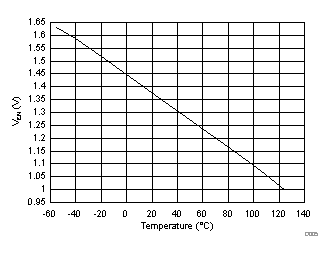
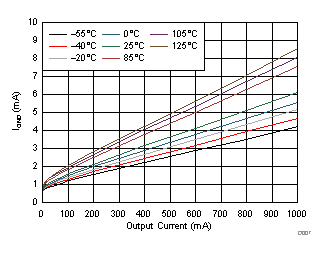
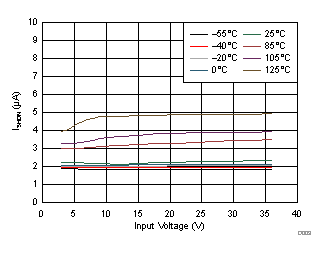
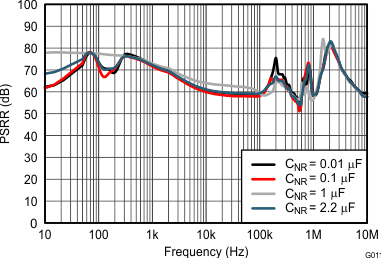
| IOUT = 1 A | COUT = 50 µF | VIN = 3 V |
| VOUT = 1.4 V |

| CNR = 1 µF | COUT = 50 µF | VIN = 3 V |
| VOUT = 1.4 V |
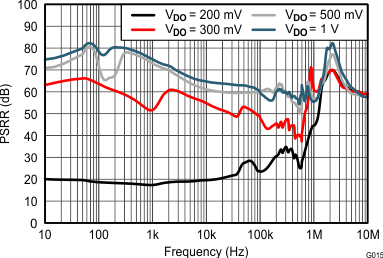
| VOUT = 3.3 V | CNR = 1 µF | COUT = 50 µF |
| IOUT = 500 mA |
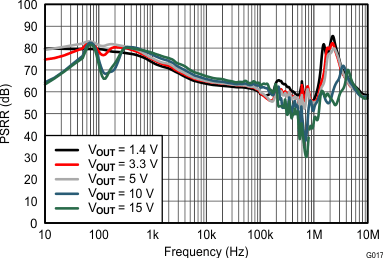
| CNR = 1 µF | COUT = 50 µF | IOUT = 500 mA |
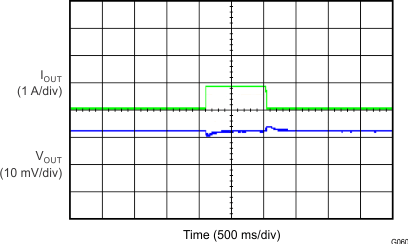
| VIN = 5 V | VOUT = 3.3 V | IOUT = 10 mA to 845 mA |
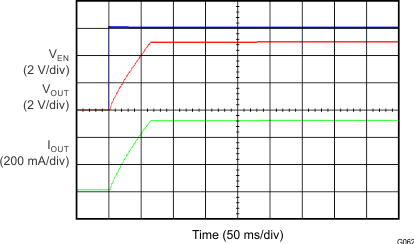
| Startup Time = 65 ms | VIN = 6 V | VOUT = 5 V |
| IOUT = 500 mA | CIN = 10 µF | COUT = 50 µF |
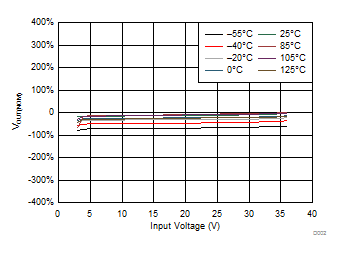
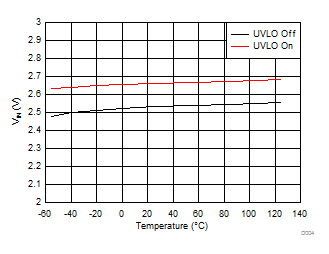
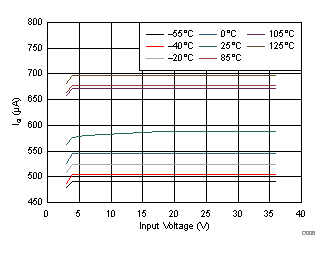
| IOUT = 0 µA |
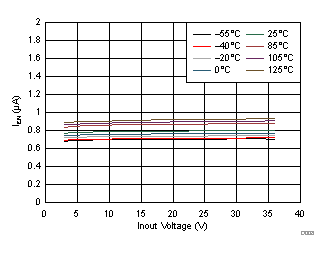
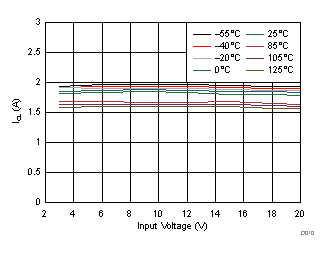
| VOUT = 90% VOUT(NOM) | ||
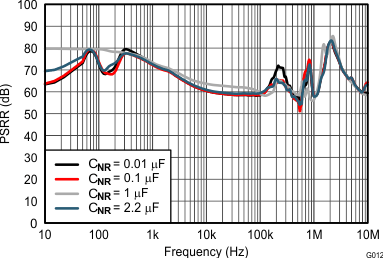
| IOUT = 0.5 A | COUT = 50 µF | VIN = 3 V |
| VOUT = 1.4 V |
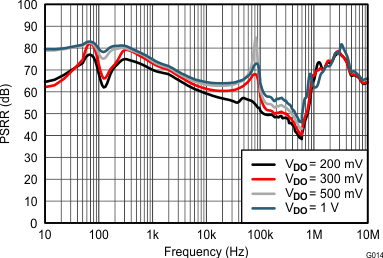
| VOUT = 3.3 V | CNR = 1 µF | COUT = 50 µF |
| IOUT = 50 mA |
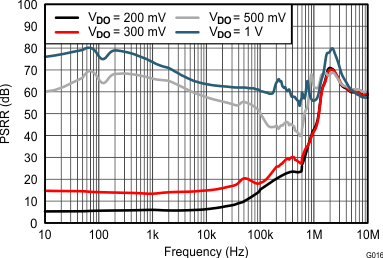
| VOUT = 3.3 V | CNR = 1 µF | COUT = 50 µF |
| IOUT = 1 A |
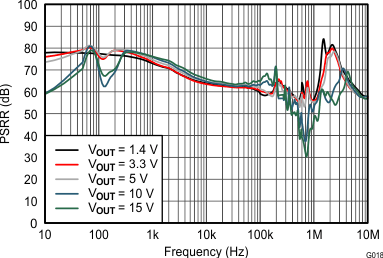
| CNR = 1 µF | COUT = 50 µF | IOUT = 1000 mA |
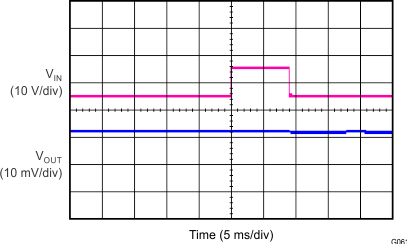
| VIN = 5 V to 15 V | VOUT = 3.3 V | IOUT = 845 mA |
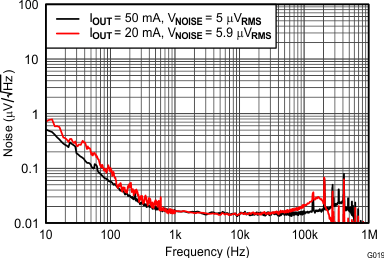
| VOUT = 4.7 V | COUT = 10 µF | CNR = 1 µF |
| BWRMSNOISE (10 Hz, 100 kHz) | ||